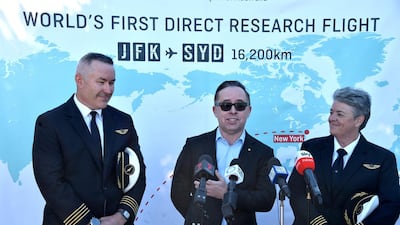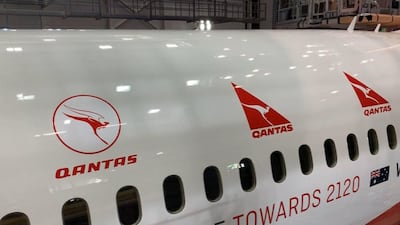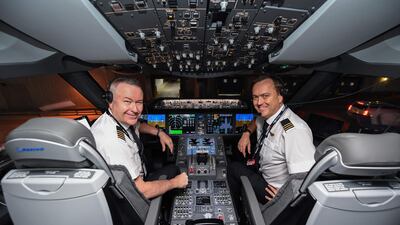It's the ultimate test of mental and physical limits for both passenger and plane, and experts even think it will minimise the traveller's enemy - jet lag.
Qantas flies into the unknown on Friday with the first of its three "ultra long-haul" test flights, the first an almost 20-hour odyssey from New York to Sydney non-stop.
The Boeing 787-9 will not land Down Under until Sunday morning, itself a quirk in aviation.
Researchers will monitor the effects on the 40 passengers on the journey - most of them Qantas employees - on the 16,000-kilometre westbound flight. Just think of the air miles.
The passenger count has been limited to minimise weight and give the Dreamliner sufficient fuel range.
Sean Golding, the aircraft’s captain, said the plane should land in Sydney with about 90 minutes of fuel in the tanks. The brand-new jet will take off with about 101 tonnes of fuel, he said.
No other airline has ever achieved the feat, which Qantas chief executive Alan Joyce has called the "final frontier in aviation".
Scientists from two Australian universities will be on board to monitor passengers' sleep patterns, melatonin levels, and food consumption. Pilots will also wear a device that tracks their brain waves and alertness.
Here's what the researchers are getting passengers and pilots to monitor:
- Six Qantas frequent flyers will follow a pre-planned schedule for eating, drinking, sleeping and moving
- They'll keep a daily log before and during the flight, as well as for two weeks afterward to gauge how they feel
- Pilots will wear brain-monitoring equipment to assess their alertness and will provide urine samples to track melatonin levels
The research on the Qantas passengers is designed to answer three central questions:
- How does their sleep, cognitive ability, sleepiness and mood change on an ultra-long-haul flight?
- How quickly do they adapt to the destination's time zone?
- Do the changes to the in-flight routine actually improve passenger experience?
Jet lag busting flight?
With a 15-hour time difference between New York and Sydney, the impact of jet lag will be closely watched.
"We know from the basic science of circadian rhythms that a bigger time difference between departure and arrival locations, and travelling east rather than west, tends to mean people feel more jet lag," University of Sydney professor Stephen Simpson told AFP.
"But people seem to be wildly different when it comes to the experience of jet lag - and we need more research on what contributes to jet lag and travel fatigue, so we can try and reduce the impact of long-haul flights."
Logistics worker Greig Roberts is taking the trip will be a chance to learn how to deal better with jet lag, which can knock him about for days after taking a long flight.
“That is the appeal for me,” he told Bloomberg. “If you can arrive feeling fresh and buzzing, that can be very productive.”
Going the distance
Qantas last year introduced the first direct service from Perth to London, a 17-hour journey that's one of the longest scheduled passenger flights in the world. Mr Joyce says that route is "95 per cent full".
But, that's not even the longest flight in the world. The current record-holder is the Singapore Airways' route to New York Newark. Here's the top 5:
As well as the New York-Sydney route, Qantas will test a service from London to Sydney in the coming months.
The airline is considering launching commercial services on the marathon routes - if the economics stack up.
A decision will be made on the validity of the flights at the end of the year. Mr Joyce has said it is "ultimately a business decision".
What do the pilots think?
Another hurdle could come from within the organisation.
Qantas pilots have raised concerns about the impact of ultra long-range flying on safety standards.
The Australian and International Pilots Association (AIPA), which represents Qantas pilots, said the exploratory flights "will produce a limited set of data that will not adequately replicate real-world flying conditions".
AIPA safety director Shane Loney has called for a "scientific long-term study" into the impacts on crew.
"Pilots are concerned about being able to get enough quality rest during ultra long-range flights to maintain peak performance and we believe significant caution should be exercised in the initial operations to make sure there are no unintended consequences," he said.
A Qantas spokesperson said the test flights are "just one part of the work we are doing to assess how to the operate these flights safely".
Both Airbus and Boeing have pitched aircraft for the Qantas ultra long-haul routes. Mr Joyce has said it is not a "foregone conclusion" which company will be chosen.
Boeing 777-8 production date up in the air
The date of entry into service of Boeing's new 777 will depend partly on customer demand, an executive at the American manufacturer said on Wednesday.
Qantas said it could order Boeing's 777-8 or the rival Airbus SE A350-1000 for the longest commercial flights in history by the end of this year, with hopes of delivery from late 2022.
"Our timetable on the 777-8 obviously is still under consideration for when it actually enters service," Darren Hulst, a senior Boeing marketing executive said.
Emirates has 35 orders for the 777-8s on order, but Tim Clark has said some 777X orders could be switched to 787s.











